ប្រាសាទបល្ល័ង្ក មានទីតាំងស្ថិតនៅភូមិដងតាឯក ឃុំដូង ស្រុកប្រាសាទបល្ល័ង្ក ខេត្តកំពង់ធំ ខាងត្បូងសាលាឃុំដូងប្រមាណ១,៥គីឡូម៉ែត្រ និងមានចម្ងាយពីទីរួមទីរួមខេត្តកំពង់ធំប្រមាណ ៥៥គីឡូម៉ែត្រ។ ឈ្មោះប្រាសាទ «បល្ល័ង្ក» ជាឈ្មោះដែលកត់ត្រានៅក្នុងបញ្ជីស្ថានីយបុរាណវិទ្យានៅក្នុងខេត្តកំពង់ធំ ដោយក្រសួងវប្បធម៌ និងវិចិត្រសិល្បៈ សហការជាមួយសាលាបារាំងចុងបូព៌ាប្រទេស។ ប៉ុន្តែអ្នកស្រុកនៅក្នុងតំបន់ពុំហៅប្រាសាទនេះថា «បល្ល័ង្ក» ឡើយ ពោល គឺគេហៅទីនោះថា «ព្រៃអ្នកតាចាស់ស្រុក» ដោយហេតុថា នៅខាងមុខប្រាសាទ គឺជាទីតាំងអ្នកតាចាស់ស្រុកនិងជាកន្លែងជំនឿដ៏ស័ក្តសិទ្ធសម្រាប់ប្រជាជនក្នុងតំបន់។ ប៉ុន្តែនៅទិសអាគ្នេយ៍ប្រាសាទ មានទួលបុរាណមួយដែលធ្លាប់ជាអតីតទីរួមស្រុកកាលពីចុងទសវត្សរ៍១៩៨០មានឈ្មោះថា «ទួលបល្ល័ង្ក»។ ហេតុដូច្នេះហើយ ឈ្មោះថា «បល្ល័ង្ក» មិនមែនសំដៅលើប្រាសាទទេ គឺសំដៅទៅលើទួលដែលនៅក្បែរនោះ។ ចំណែក ពាក្យ «បល្ល័ង្ក» ទៀតសោត ក៏មិនមានសំដៅទៅលើជើងទម្រឬព្រះថែនបដិមាឡើយ តែជាឈ្មោះរុក្ខជាតិម្យ៉ាងដែលមានដើមស្រដៀងដើមពាតអញ្ជាំង មានស្លឹកធំៗរាងទ្រវែងស្រដៀងដៀងស្លឹកកាស្យា តែធំជាង រីឯផ្លែមានទំហំប្រហែល ១,៥ស.ម. ស្រដៀងផ្លែព្រីង រសជាតិក៏ដូចព្រីង មានរាងស្រដៀងបេះដូងមនុស្ស ផ្លែមកមានទងវែងៗដូចផ្លែភ្ញាវ គ្រាប់ដុតឈ្ងុយមានប្រេងច្រើនរាងល្ងើ ហើយជាទូទៅអ្នកស្រុកនៅកំពង់ធំ គេចែកដើមនេះជាពីរប្រភេទ គឺបល្ល័ង្កដំរី និងបល្ល័ង្កវល្លិ៍។

កាលពីសម័យអាណានិគមបារាំងមក ប្រាសាទនេះពុំធ្លាប់មានការសិក្សាស្រាវជ្រាវពីអ្នកស្រាវជ្រាវមកពីតំបន់អឺរ៉ុប ឬការចុះបញ្ជីម្តងណាឡើយ ពោល គឺទើបតែនៅស.វ.ទី២១នេះប៉ុណ្ណោះ ដែលមានការចុះបញ្ជីក្នុងក្របខណ្ឌក្រសួងវប្បធម៌ និងវិចិត្រសិល្បៈ កាលពីឆ្នាំ២០០៨។ ប្រាសាទបល្ល័ង្ក សង់ឡើងអំពីឥដ្ឋលើគ្រឹះថ្មបាយក្រៀម មានរាងបួនជ្រុងទ្រវែង ហើយមានយ៉លយមកទិសខាងកើត។ ល្វែងខាងមុខរបស់យ៉មានច្រកទ្វារពីរបែរមុខទៅទិសខាងត្បូង និងខាងជើង។ ក្រៅអំពីទ្វារចូលនៅទិសខាងកើត សិល្បករបានលម្អជាទ្វារបញ្ឆោតនៅទិសសំខាន់ៗ ទាំងបីផ្សេងទៀត។ ទ្វារបញ្ឆោតនីមួយៗធ្វើអំពីថ្មភក់ ដោយរៀបថ្មភក់ចេញជារាងស៊ុមទ្វារ ដែលនៅចំកណ្តាលគេលម្អជាសន្ទះទ្វារមានសសរពេជ្ររាងប្រាំបីជ្រុង និងសសរផ្អោបអមសងខាង។ ខឿនរបស់ប្រាសាទ គេរៀបថ្មភក់មានរាងសារពើសូត្រថ្នាក់ៗ ហើយរៀបឥដ្ឋតួប្រាសាទពីលើដែលគ្រឹះក្រោមជាថ្មបាយក្រៀម។ ប្លង់ប្រាសាទបែបនេះ មានលក្ខណៈស្រដៀងនឹងតួប៉មកណ្តាលភ្នំជីសូរគុកនគរ របងរមាស។ល។

ប្រាសាទនេះ ហ៊ុមព័ទ្ធដោយកសិន្ធុទឹកជុំវិញរាងបួនជ្រុង មានផ្លូវចូលពីទិសខាងកើត និងមានស្រះធំមួយនៅទិសខាងជើង។ ស្រះខាងជើងមានប្រវែងបណ្តោយ ២១៥ម៉ែត្រ និងទទឹង៨៥ម៉ែត្រ។ នៅរវាងឆ្នាំ២០០៥ ប្រាសាទនេះនៅឈរមានរូបរាងល្អនៅឡើយ តែសព្វថ្ងៃផ្នែកដំបូលបាក់បែកជ្រុះឥដ្ឋមកក្រោមអស់ហើយ រីឯផ្ទៃជញ្ជាំងបានហែកចេញពីគ្នាស្ទើរតែបាក់រលំ។ ប៉ុន្តែទោះបីជាយ៉ាងណា ប្រាសាទនេះនៅតែមានការអភិរក្សនិងការគាំពារជាប្រចាំពីមន្ទីរវប្បធម៌និងវិចិត្រសិល្បៈខេត្តកំពង់ធំ រួមជាមួយអាជ្ញាធរមូលដ្ឋាន និងប្រជាពលរដ្ឋ។

នៅបរិវេណប្រាសាទ មាននៅសល់វត្ថុសិល្បៈធ្វើអំពីថ្មភក់ជាច្រើនដុំដែលភាគច្រើនគេរក្សាទុកនៅខ្ទមអ្នកតាចាស់ស្រុកនៅខាងមុខប្រាសាទ។ ក្នុងនោះមានផ្តែរទ្វារមួយដែលនៅចំពាក់កណ្តាលមានឆ្លាក់រូបទេពកំពុងអង្គុយនៅលើក្បាលរាហូ អមដោយតោពីរឈរហាមាត់ខាំ ឬលេបក្បាច់បន្ទាត់ធ្នូរាងដូចមែកឈើ ផ្នែកខាងលើនិងផ្នែកខាងក្រោមផ្តែរលម្អជារំយោលផ្កានិងកម្រងមាលា។ រូបចម្លាក់ទេពដែលនៅពីលើក្បាលរាហូ យើងមិនដឹងថាជាទេពអ្វីឱ្យប្រាកដនោះទេ ដ្បិតរូបនេះគេប្រមូលចេញពីទីតាំងដើមទៅហើយ តែបើសិនជាផ្តែរនៅទិសខាងជើងអាចជាព្រះកុវេរ ខាងត្បូងជាព្រះយម ខាងកើតជាព្រះឥន្រ្ទ និងខាងលិចជាព្រះភិរុណ។ ម្យ៉ាងវិញទៀត កេតនភណ្ឌ ឬអាវុធរបស់ទេពដែលកាន់ជាប់នឹងព្រះហស្តក៏រលុបពិបាកមើលទៀត តែវាមានលក្ខណៈស្រដៀង «វជ្រ» ដែលអាចសន្និដ្ឋានបឋមថា ទេពកណ្តាលនោះ គឺជាព្រះឥន្រ្ទ។ ក្រៅអំពីផ្តែរនៅមានបំណែកចុងហោជាងរូបមករខ្ជាក់នាគ បំណែកចម្រឹងបង្អួច សសរពេជ្ររាងប្រាំបីជ្រុង ជើងទម្រ មេទ្វារ។ល។ ក្បាច់លម្អទាំងនេះ មានលក្ខណៈជាសិល្បៈរចនាបថឃ្លាំងឬបាភួននៅក្នុងស.វ.ទី១១ ពោល អាចស្ថិតនៅក្នុងរជ្ជកាលព្រះបាទសូរ្យវរ្ម័នទី១ (គ.ស. ១០០២-១០៤៩)។


នៅប្រាសាទបល្ល័ង្ក មិនមាននៅសេសសល់ភស្តុតាងសិលាចារឹកឱ្យយើងសិក្សានោះទេ ប៉ុន្តែយើងអាចប្រៀបធៀបសំណង់នេះជាមួយសំណង់ផ្សេងទៀតដូចជា ប្រាសាទរបងរមាស ប្រាសាទគុកនគរ ប្រាសាទភ្នំជើងព្រៃ ប្រាសាទភ្នំជីសូរ យើងនឹងអាចទាញសេចក្តីសន្និដ្ឋានមួយថា ប្រាសាទបល្ល័ង្ក គឺជាសំណង់សាសនាមួយឧទ្ទិសដល់ព្រហ្មញ្ញសាសនា ឬព្រះពុទ្ធសាសនា ក្នុងចុងស.វ.ទី១០ ដើមស.វ.ទី១១ រវាងរជ្ជកាលព្រះបាទជ័យវរ្ម័នទី៥ (គ.ស.៩៦៨-១០០០) ឬព្រះបាទសូរ្យវរ្ម័នទី១ (គ.ស.១០០២-១០៤៩)៕
—————————–
Prasat Balang
Prasat Balang is located in Dang Ta Ek Village, Doung Commune, Prasat Balang District, Kampong Thom Province, approximately 1.5 km south of Doung Commune Hall and about 55 km from Kampong Thom Provincial Town. The name “Balang” was recorded on the list of archeological sites in Kampong Thom province by the Ministry of Culture and Fine Arts in collaboration with the EFEO Centre. The locals do not call this temple “Balang”, that is, it is called “Prey Neak Ta Chas Srok” because in front of the temple is the location of Nek Ta Chas Srok and a sacred place for the people in the Area. However, the southeast of the temple has an ancient hill, which used to be the former district town in the late 1980s, called “Tuol Balang”. Therefore, the name “Balang” does not refer to the temple, but to a nearby hill. The word “Balang” does not refer to the pedestal or throne statue but is the name of a plant that has a stem similar to the local tree and the locals in Kampong Thom generally divide this tree into two types: the Balang of the elephant and the Balang of the vine.
In the French colonial period, the temple was never studied by researchers from Europe or registered, only in the 21st century, which is registered under the Ministry of Culture and Fine Arts in 2008. Prasat Balang is built of bricks on a laterite foundation, is rectangular in shape, and has a balcony to the east. The front of the balcony has two gates facing south and north. In addition, there is the east entrance and three blind doors decorative in the other three main directions. The plan of such temples is similar to the central tower of Phnom Chisor, Kuha Nokor, Robang Romeas, etc.
The temple is surrounded by a moat in a square shape, with an entrance from the east and a large pond to the north. The northern pond is 215 meters long and 85 meters wide. By 2005, the temple was still in good condition, but today the roof collapsed and the bricks have fallen, and the walls are almost torn apart. However, the temple still has the conservation and protection of the Department of Culture and Fine Arts of Kampong Thom province, as well as with local authorities and residents.
Around the temple, there are many sandstone artifacts, most of which are kept in the Neak Ta hut in front of the temple. Also, there is a lintel that is the center part carved with an image of a deity sitting on the Rahu head, accompanied by two lions standing with their mouths biting or swallowing a tree-shaped bow and decorated with flower tassels and garlands. Regarding the statue of the deity above Rahu head, we do not know for sure what kind of deity, because this image has been removed from the original location. On the other hand, the weapon of the deity was ready to damage, but it can be recognized as similar to “Vajra” which can initially conclude that the central deity is Indra. In addition, there are remaining pieces of pediment figuring Makara spit out Naga, the pieces of the baluster window, the octagonal colonnettes, pedestals, door frames, etc. These ornaments were in the style of Khleang or Baphuon in the 11th century, probably during the reign of King Suryavarman I (1002-1049 AD).
Prasat Balang, there is no inscription evidence left for us to study, but we can compare this structure with other temple structures such as Robang Romeas Temple, Kuha Nokor Temple, Phnom Cheung Prey Temple, Phnom Chisor Temple, we will be able to draw a conclusion that Prasat Balang is a religious structure dedicated to Brahmanism or Buddhism in the late 10th century, early 11th century, during the reign of Jayavarman V (968-1000) or Suryavarman I (002-1049).
អត្ថបទដើម៖ លោក ម៉ង់ វ៉ាលី






